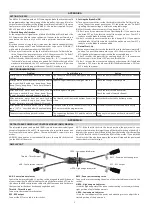
88
SINUS motorglider
www.pipistrel.si
REV. 0
89
SINUS motorglider
www.pipistrel.si
REV. 0
Appendix
Take off and initial climb
Having checked and set all engine and aircraft parameters, you should be ready for take off by now.
Reverify both fuel valves be open and the spoilers (airbrakes) retracted and locked (handle full
up). Trim lever should be in the middle.
I would suggest you
start the take-off roll gradually.
Keep adding throttle to full power while count-
ing 21, 22, 23, 24, 25. There are two reasons for this. First, you change flight stage from zero move-
ment to acceleration slowly; this provides you with time to react to eventualities. Second, especially
if taking-off from a gravel runway, this method of adding full throttle will prevent the little stones on
the runway to damage the propeller. Extremely short runways are an exception. There you should
line up the aircraft, set flaps to 2
nd
stage, step on the brakes, apply full power and release the brakes.
As you start to move, push ste stick 1/3 of elevator’s deflection forward.
How much is that? The stick should be where your knees are. This will make you lift the aircraft’s tail
and accelerate even more. Most pilots ask exactly how much the tail should be lifted during ground
roll. There is no exact rule for this but if you align the horizon at the end of the runway with the line
where the windshield begins above the instrument panel, you should be well off.
Basically if you lift the tail properly, there is nothing else but a gentle pull on the stick to make
the aircraft airborne.
Crosswind take-offs, depending on wind strength, require a little bit of aileron
deflection into the wind.
Remember, wings must stay level thoughout ground-roll, rotation and
initial climb!
Having lifted off the ground, gently push the stick forward just a bit to accelerate.
At some 75 - 80
km/h
(40 - 43 kts)
set flaps to 1
st
stage, at 90 km/h
(50 kts)
set them to neutral.
Climb
A comfortable setting for climb is flaps in neutral position, speed of 115 km/h
(62 kts)
at some 5000
RPM (912 version) and full power for 2-stroke engines. In summer time or
when outside tempera-
ture exceeds 30°C
you should
consider climbing at some 130 km/h
(70 kts)
to provide more airflow
to the engine radiators. Trim the aircraft for comfortable stick forces.
Cruise
Passing through 140 km/h
(75 kts)
, set flaps to negative positon (handle full down).
A confort-
able cruise setting is 25 InHg manifold pressure with 4500 engine RPM. Take advantage of the Vario
propeller to meat these settings. For those who do not have a manifold pressure gauge installed, set
engine to 5000 RPM at flat pitch and then screw the propeller pitch knob to the right to meet 4500
RPM. Of course, cruising can be conducted at various power, propeller and flap settings.
As the Sinus ultralight motorglider is sensitive to flap setting, ALWAYS use negative stage of flaps
beyond 150 km/h
(80 kts)
and neutral below 130 km/h
(70 kts)
.
Cruising fast, do not kick-in rudder for turns!
Above 160 km/h
(85kts)
the rudder becomes almost
insignificant in comparison to aileron deflections when it comes to making a turn.
Cruising fast, it
is extremely important to fly coordinated (ball in the middle) as this increases efficiency and de-
creases side-pressure onto vertical tail surfaces. Also, pay attention to turbulence. If you hit wake
turbulence, reduce power immediately and increase angle of attack to reduce speed.
If necessary,
set flaps to neutral position (below 130 km/h,
70 kts
).
If flying a traffic pattern, keep flaps in neutral position and set engine power so that airspeed does
not exceed 150 km/h
(80 kts)
.
Summary of Contents for Sinus 503
Page 5: ...5 SINUS motorglider www pipistrel si REV 0 ...
Page 6: ...6 SINUS motorglider www pipistrel si REV 0 This page is intentionally left blank ...
Page 8: ...8 SINUS motorglider www pipistrel si REV 0 This page is intentionally left blank ...
Page 11: ...11 SINUS motorglider www pipistrel si REV 0 Aircraft projections General ...
Page 12: ...12 SINUS motorglider www pipistrel si REV 0 This page is intentionally left blank ...
Page 20: ...20 SINUS motorglider www pipistrel si REV 0 This page is intentionally left blank ...
Page 48: ...48 SINUS motorglider www pipistrel si REV 0 This page is intentionally left blank ...
Page 54: ...54 SINUS motorglider www pipistrel si REV 0 This page is intentionally left blank ...
Page 93: ...93 SINUS motorglider www pipistrel si REV 0 Appendix This page is intentionally left blank ...
Page 102: ...102 SINUS motorglider www pipistrel si REV 0 This page is intentionally left blank ...
Page 108: ...108 SINUS motorglider www pipistrel si REV 0 This page is intentionally left blank ...
















































